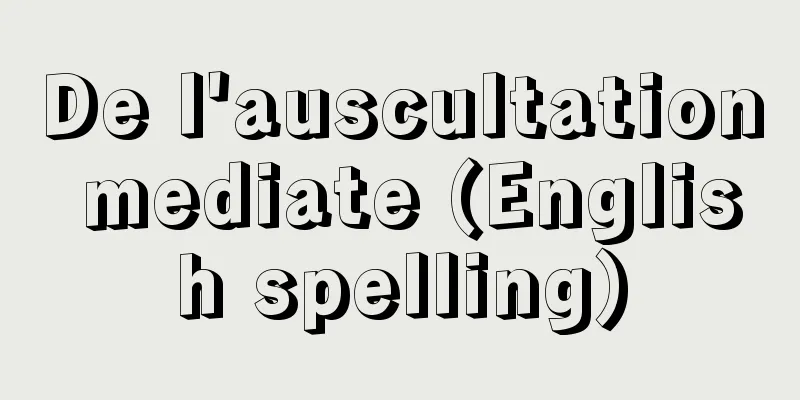Rhyming book - Insho

|
A dictionary that classifies and arranges Chinese characters according to their rhymes (the part of the character's sound excluding the initial consonant). It was compiled out of the need for rhyming when composing poetry and fu, and lists the rhymes and the characters that belong to them, often grouped by homophone with a counter-cut marker. Usually, the Four Symphony Song by Shen Yue of the Liang Dynasty in China is considered to be the first, but the format was not established until Lu Fayan and others compiled the Qiyun (601), which has 193 rhymes. Many more rhyme books were passed down after that, and the Dasong Zhongxiu Guangyun (1008), a compilation of these Qiyun-based rhyme books, is divided into 206 rhymes. However, as phonological changes occurred, the rhymes classified as such began to differ from the actual pronunciation, so the "Jinshi New Edition Libu Rhyme Sheet" (1252) reorganized the rhymes to 107 rhymes. One rhyme was removed from this to create the 106 rhymes known as "Ping Shui Rhyme" (Poetry Rhyme), which has remained the standard for rhyming to this day. Other notable works include the "Mongol Zi Rhyme" (1308) and the "Chugen On Rhyme" (1324). Meanwhile, from the end of the Tang Dynasty, under the influence of Siddham studies and research into Western alphabets, "rhyme diagrams" were created in which characters with the same initial consonant were arranged vertically and characters with the same rhyme were arranged horizontally, and books were written that systematically illustrated phonology. The "Yunkyo" (created around the 10th century) is a representative example of this, consisting of 43 diagrams, classifying initial consonants into 36 and further subdividing rhymes into four types based on differences in tone. "Qiyun" and "Yunkyo" were also introduced to Japan and were widely used. "Tougu Qiyun" (written by Sugawara no Koreyoshi) is a collection of rhyming books based on rhyming, but there are also rhyming books written in Japan, such as "Shubun Yunlue" (written by Kokan Shiren) and "Hyota Jiruisho." [Takuya Okimori] [Reference] |Volume 1, compiled by Chen Pengnian and Qiu Yongdeng, published in the Southern Song Dynasty, held at the National Diet Library "> "Great Song Dynasty Refined Guangyun" Published in 1564 (Eiroku 7) ( Owned by the National Diet Library ) "Rhyme Mirror" Satsuma version, 5 volumes, by Tokan Shiren, published in 1481 (Bunmei 13), held at the National Diet Library "Collected Rhymes" Source: Shogakukan Encyclopedia Nipponica About Encyclopedia Nipponica Information | Legend |
|
漢字をその韻(字音のうち頭子音を除いた部分)によって分類、配列した字書。詩賦をつくるときなどに押韻する必要から編集されたもので、韻目を掲げて、所属字を、多くは同音ごとに反切標示のもとにまとめて列記してある。普通、中国梁(りょう)の沈約(しんやく)の『四声譜』を嚆矢(こうし)とするが、体裁が整うのは陸法言(りくほうげん)ら編の『切韻』(601)からで、韻目数は193である。その後多数の韻書が伝えられ、それら切韻系韻書を集成した『大宋重修広韻(だいそうじゅうしゅうこういん)』(1008)は206韻に分けている。しかし、音韻変化に伴い、分類の韻が実際の発音と異なってきたため、韻目を整理して107韻としたのが『壬子(じんし)新刊礼部韻略』(1252)である。これから1韻を削った106韻のいわゆる「平水韻」(詩韻)は、今日に至るまでの押韻の基準となった。そのほか『蒙古(もうこ)字韻』(1308)、『中原(ちゅうげん)音韻』(1324)などが注目される。 一方、唐末ごろから同じ頭子音の字を縦に、同じ韻の字を横に配列した「韻図」が悉曇(しったん)学や西域(せいいき)字母の研究の影響で作成され、音韻を体系的に図式化した書が著された。『韻鏡』(10世紀ごろ成立)はその代表的なもので、43の図表からなり、頭子音を36に分類し、韻もさらに音色の違いによって4種に細分する。日本にも『切韻』『韻鏡』などが伝来し、盛んに利用された。『東宮(とうぐう)切韻』(菅原是善(すがわらのこれよし)撰)は切韻系韻書を集録したものであるが、『聚分(しゅうぶん)韻略』(虎関師錬(こかんしれん)著)や『平他(ひょうた)字類抄』など日本で撰述された韻書もある。 [沖森卓也] [参照項目] |巻1 陳彭年・邱雍等編 南宋刊本国立国会図書館所蔵"> 『大宋重修広韻』 1564年(永禄7)刊国立国会図書館所蔵"> 『韻鏡』 薩摩版 5巻 虎関師錬著 1481年(文明13)刊国立国会図書館所蔵"> 『聚分韻略』 出典 小学館 日本大百科全書(ニッポニカ)日本大百科全書(ニッポニカ)について 情報 | 凡例 |
Recommend
Ondo Seto - Ondo Seto
A waterway between Kegoya, Kure City and Kurahash...
Watanabe Suiha
Haiku poet. Born in Tokyo. Real name Yoshi. Eldes...
Marsh, WM (English spelling)
…He worked in Dixie and Rumba bands, and at the a...
Japan - Nihon
◎Official name: Japan. ◎Area: 377,970.75 km2 . ◎Po...
Teigin robbery - Teigin robbery
On January 26, 1948, a murder and robbery using c...
Erivan' (English spelling)
…One of the leading industrial, cultural and acad...
Peroxosulfuric acid (English spelling)
There are two types of peroxomonosulfuric acid: H...
Extension - Spread
〘Other A next one (Ha next one)〙 Ha, fu 〘Other Ha ...
Yamburg
...It is estimated that there are a total of 13 t...
Object Fallacy - Customer Writing
...There are cases where the mistake is within th...
Princess Kamiatatsu
⇒ Princess Konohanasakuya Source: Kodansha Digital...
Yang-lian-yin; yang-lien-yin
A type of salary paid to local officials during th...
salon carré (English spelling) saloncarre
…The exhibits included paintings, sculptures, arc...
Freezing rain - Uhyoh
Raindrops that are supercooled near or below free...
Lathyrus quinquenervius (Lathyrus quinquenervius)
A perennial plant of the legume family, native to ...









